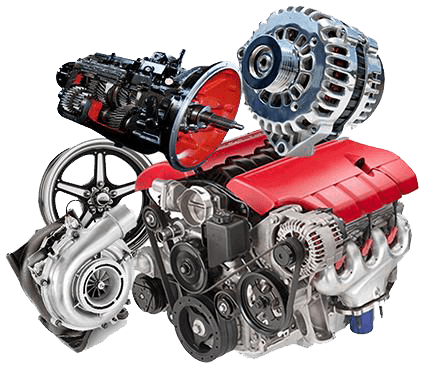Update Your Vehicle with a New Opel Corsa Engine
Update Your Vehicle with a New Opel Corsa Engine
Blog Article
Exploring the Inner Workings of a Compact Lorry's Engine System
As motorists, we commonly take for granted the detailed processes that take place within the boundaries of our vehicle's engine system. The portable yet complicated machinery that thrusts us ahead is a wonder of engineering accuracy and sychronisation. From the controlled surges in the combustion chamber to the careful timing of fuel shot, every component plays a crucial function in the smooth operation of the engine. In this exploration of a portable automobile's engine system, we will unwind the internal functions of this mechanical harmony, clarifying the enigmas that drive us forward on our day-to-day journeys.
Combustion Process Review
The combustion process in a portable lorry's engine system is an important mechanism that effectively transforms gas right into energy to power the automobile. This procedure takes place within the combustion chamber of the engine, where fuel and air mix, spark, and generate regulated explosions. The combustion process contains 4 major phases: consumption, exhaust, power, and compression.
During the intake phase, the piston moves downward, drawing in a blend of air and gas right into the burning chamber. This downward motion generates the power needed to drive the lorry. This cyclic burning process is basic to the procedure of a compact automobile's engine system, making certain efficient energy conversion for propulsion.
Piston and Cylinder Interaction

The piston's exact fit within the cyndrical tube is necessary for keeping optimum compression and protecting against power loss throughout burning. Limited clearances between the piston and cylinder walls guarantee efficient sealing, permitting the piston to relocate efficiently without enabling gases to leak past. Appropriate lubrication is also vital to reduce rubbing and wear in between these elements, enhancing durability and performance.
Furthermore, the layout and materials used in making the piston and cyndrical tube effect engine effectiveness and sturdiness. Modern engines typically employ lightweight yet sturdy products like aluminum alloys for pistons and cyndrical tube linings to decrease inertia and boost thermal performance. Generally, the harmonious communication between the piston and cylinder is basic to the engine's performance and overall efficiency.
Fuel Shot System Performance
Fuel shot systems in compact lorry engines play an essential function in precisely providing fuel to the burning chamber for efficient and regulated ignition. The fuel shot system functions by infusing gas into the burning chamber at the ideal minute throughout the engine's operation (opel corsa engine). This accurate timing makes certain that the fuel blends evenly with the air for correct combustion, causing improved fuel performance and decreased exhausts
There are primarily 2 kinds of fuel shot systems made use of in compact automobile engines: port fuel injection (PFI) and straight gas injection (DFI) PFI systems inject gas right into this content the intake port prior to the consumption valve, while DFI systems inject gas straight into the combustion chamber. Both systems have their benefits, with DFI supplying better gas atomization and PFI giving a more economical remedy.
Understanding Engine Cooling Systems
Reliable operation of a compact automobile's engine counts greatly on the effectiveness of its cooling systems. Engine cooling is vital to prevent overheating, which can result in severe damages and lowered efficiency. The air conditioning system in a compact car usually contains numerous parts collaborating to manage the engine temperature. One essential part is the radiator, which utilizes coolant to take in warm from the engine. As the hot coolant streams with the radiator, it releases warm into the air, cooling down before returning to the engine. The water pump circulates the coolant through the engine and radiator, guaranteeing a constant flow to regulate temperature. In addition, the thermostat assists regulate the coolant flow to preserve optimum engine temperature level. Some vehicles additionally have cooling down followers that activate when added cooling is required, such as throughout hefty traffic or heat. Understanding these engine air conditioning devices is crucial for preserving the performance and longevity of a portable automobile's engine system.

Exhaust System Parts Explained
The optimum functioning of a portable car's engine air conditioning mechanisms depends on a corresponding system recognized as the exhaust system, which makes up numerous vital parts for guaranteeing reliable emissions and engine performance. The exhaust manifold accumulates exhaust gases from the engine's courses and cylinders them to the catalytic converter.
One vital part of the exhaust system is the oxygen sensor, which keeps an eye on the oxygen degrees in the exhaust gases to help control gas intake and guarantee ideal engine efficiency. opel corsa engine. Additionally, the resonator may exist in some exhaust systems to minimize sound levels. In general, the exhaust system plays a crucial duty in maintaining engine efficiency, minimizing unsafe emissions, and guaranteeing a quieter driving experience for small automobile proprietors

Conclusion
To conclude, the small lorry's engine system is a complex combination of elements that interact to facilitate the combustion process, click site convert fuel right into power, and eliminate waste gases. Understanding the inner workings of the engine system, including the piston and cylinder communication, fuel injection system, engine air conditioning mechanisms, and exhaust system components, is vital for keeping ideal performance and efficiency of the automobile.
The burning procedure in a small automobile's engine system is a crucial system that effectively converts fuel into energy to power the vehicle.Gas shot systems in portable lorry engines play an essential duty in specifically supplying gas to the combustion chamber for effective and controlled ignition.There are largely 2 types of fuel injection systems used in portable automobile engines: port gas injection (PFI) and direct gas shot (DFI) Comprehending these engine cooling mechanisms is essential for keeping the efficiency and long life of a check here small car's engine system.
The optimal performance of a portable car's engine cooling devices depends on a corresponding system understood as the exhaust system, which makes up various vital components for ensuring reliable discharges and engine performance.
Report this page